A road to Ontario’s Ring of Fire? Doug Ford still can’t pay for it
Doug Ford’s Progressive Conservatives call the Ring of Fire a “corridor to prosperity.”
The remote region in Ontario’s Far North, known for the mineral deposits that lie beneath its boggy peatlands, has had a special place in Ford’s plans for Ontario since the 2018 provincial election, when he promised to build an all-season road there even if he had to “hop on a bulldozer” himself. Now, with Ford seeking a second term as premier, the Ring of Fire is once again front and centre.
On the campaign trail in northern Ontario on May 7, Ford accused the other parties of being “all talk but no action,” saying the Progressive Conservatives “will get it done and build the road to the Ring of Fire.”
But internal briefing notes and correspondence obtained by The Narwhal show that a vital component of the Ford government’s plan to do so is sputtering out instead of gaining momentum. The 565 pages, obtained through 20 separate freedom-of-information requests to the provincial and federal governments, show that Ontario is no closer than it was in 2018 to securing the $1 billion in federal funding it needs to pay for roads and other infrastructure.
Without funding and the roads it would build, mining development in the Ring of Fire cannot happen.
For at least two years, from 2019 to 2021, senior officials from the provincial and federal governments failed to meet to advance negotiations. “The co-funding request fell through the cracks and has yet to be revived,” said a briefing note prepared for officials with Indigenous Services Canada in August 2021.


Ontario pushed forward work on various environmental assessments for two road projects during those two years, including a regional assessment sparked by the federal government, aimed at examining the cumulative impact of development in the area. But the process has so far been hampered by COVID-19 delays and pushback from several First Nations in the region, including a court challenge from Neskantaga First Nation. Neskantaga — which has been under a boil water advisory for 26 years, the longest such advisory in Canada — is arguing the federal government’s consultation on the Ring of Fire is “inadequate,” especially given extra challenges due to COVID-19.
“The attitude that Ontario has projected all along is that it wants to kind of put its head down and pretend that everybody is on board with this — and hope that people in the south will be not paying close enough attention to realize that everybody is not on board,” said Dayna Nadine Scott, the co-director of the environmental justice and sustainability clinic at York University’s Osgoode Hall Law School, who also advises Neskantaga First Nation.
Meanwhile, the costs of the project are increasing, creeping up from between $1.1 billion and $1.6 billion in 2019 to over $2 billion. That’s according to a September 2021 internal briefing note to the office of Greg Rickford, Ontario’s minister of northern development, mines, natural resources and forestry and also minister of Indigenous affairs. Officials from both governments are still internally relying on outdated estimates for the value of minerals in the Ring of Fire, which were authored nearly a decade ago and debunked as “nonsense” by the Globe and Mail in 2019. And the federal government is staying mum about whether it’s willing to commit serious money to the project.
Rickford’s office did not grant a request for an interview with the minister and did not answer detailed questions from The Narwhal about the information in various documents.
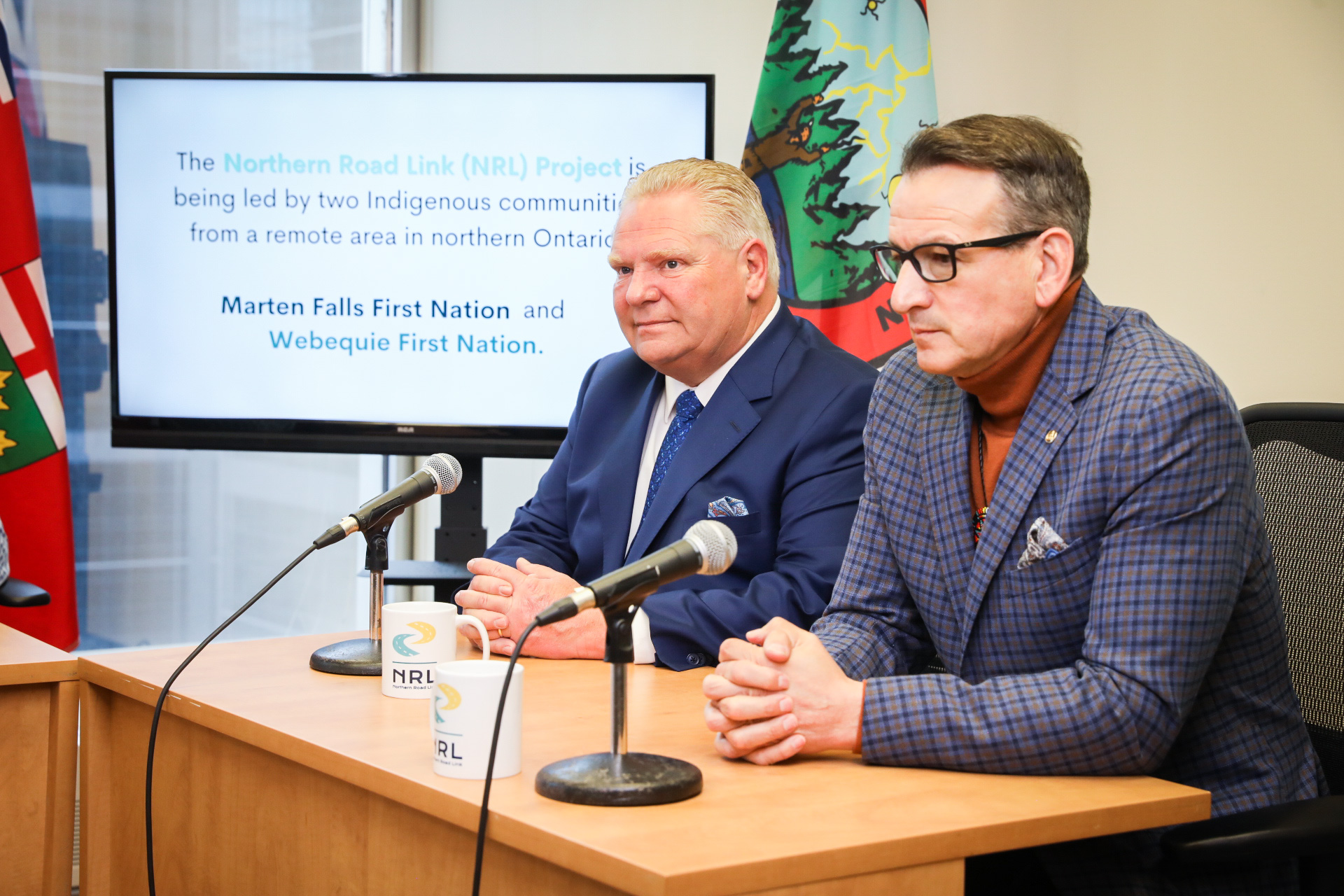
“Premier Ford is getting it done by unleashing the mineral might of the north with a $1 billion investment for an all-season road network into the Ring of Fire,” wrote Curtis Lindsay, a spokesperson for Rickford, in an email.
Kate Kempton, a lawyer representing Attawapiskat First Nation — which would be affected by development in the Ring of Fire — said the entire concept has “unequivocally been proven to be stupid and wrong.”
“For 500 years, stupid white men have led us to the edge of climate collapse,” she said.
“This is what we have, the idea that environmental concerns are just a political chess piece. And they can all be dealt with at some point after the thing is built and the harm is done.”
The office of federal Natural Resources Minister Jonathan Wilkinson declined an interview request from The Narwhal.
“We will continue to support efforts to develop the Ring of Fire, as well as its surrounding communities, in an environmentally sustainable manner and in collaboration with local First Nations and the Government of Ontario, taking into account the need for environmental assessment and regulatory approval before any development can proceed,” Natural Resources Canada said in an email.
It burns, burns, burns, the Ring of Fire
Building a road to the Ring of Fire is no simple thing. The prospect has eluded governments and mining companies in Ontario for more than a decade.
The region, which was named after a Johnny Cash song and the shape of its mineral deposits on a map, is located on peatland in Treaty 9 territory, about 540 kilometres northeast of Thunder Bay, Ont. It’s accessible only by air or by ice roads in the winter — there are no permanent roads, and the area lacks other basic infrastructure.
“No single mining company can carry the financial burden of building the needed road infrastructure,” read a September 2021 briefing note to Rickford’s office, marked as “confidential intergovernmental advice.”
The northern landscape can also make such projects tricky — for example, an effort to improve internet access for five remote First Nations near the Ring of Fire was set back by a year due to the “loss of amphibious equipment through the ice,” according to a March 2021 meeting note for a video call between Rickford and a deputy minister. Rickford’s office did not answer a question about the current status of the internet access project, which is jointly funded by the Ontario and federal governments, but a March 2022 briefing note to Rickford said the communities were scheduled to be connected to the broadband network by early 2023.
Industry and governments believe minerals in the Ring of Fire — like nickel, which is used in many electric vehicle batteries — could put Ontario in position to supply the world with the materials needed for technologies that could help lower global greenhouse gas emissions. Mining companies around the world are rushing to secure supplies of nickel ahead of a forecasted surge of demand. Two major Australian companies, Wyloo Metals and BHP, got into a bidding war last year to gain control of the leading Canadian company in the Ring of Fire, Noront Resources. Wyloo closed the deal last month and bought Noront for $616.9 million. (Rickford briefly sat on Noront’s board before entering provincial politics.)
Environmental advocates and some First Nations question whether development in the Ring of Fire is a good idea at all, given the importance and sensitivity of the landscape. Northern Ontario’s peatlands sequester an estimated 35 billion tonnes of carbon, the equivalent of a year’s worth of emissions from seven billion cars. The landscape doesn’t naturally recover once it’s been disturbed by humans. The area is also an important habitat for wildlife.
In a 2021 Natural Resources Canada memo also released through freedom-of-information legislation, the federal department acknowledged the region’s importance as a “carbon sink.” The memo notes that the Ring of Fire is “considered as having some of the last original, intact forest in North America, and is home to a number of species at risk,” including caribou, lake sturgeon, wolverines and bald eagles.”
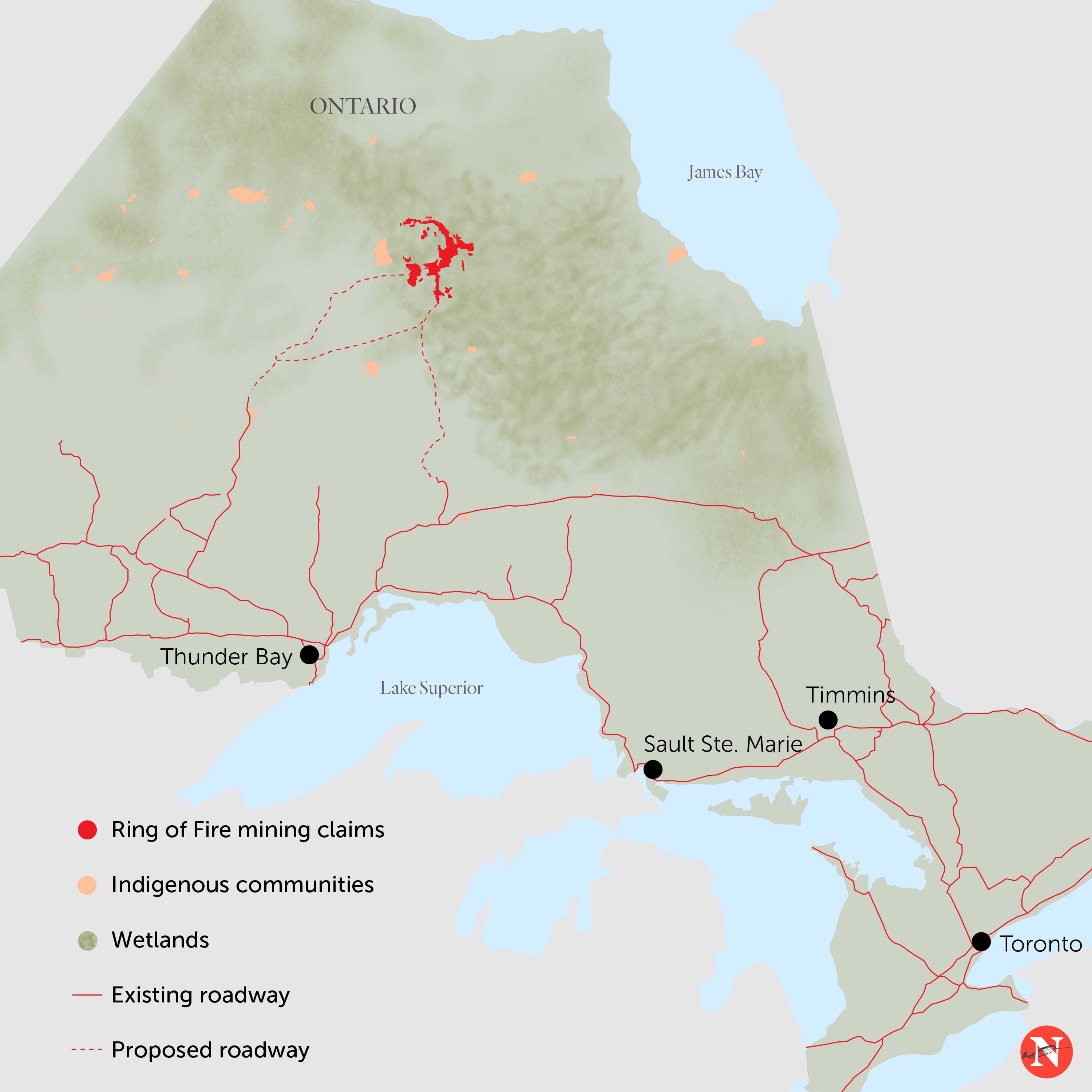
Then again, roads aren’t just about mining. More than a dozen First Nations live near the Ring of Fire, and many are coping with long-term boil water advisories, youth suicides, poverty and high food prices. Though there are a wide range of opinions, some First Nations see all-season roads linking their communities to the south as a way to improve their communities’ quality of life. Marten Falls and Webequie First Nations are backing efforts to build access roads to their communities.
“Why can’t youth be supported in these kinds of essential things that our forefathers had envisioned when they signed the treaty?” Marten Falls Chief Bruce Achneepineskum told The Narwhal last year. (Achneepineskum and Webequie Chief Cornelius Wabasse didn’t respond to interview requests for this story by publication time.)
Other First Nations aren’t sure that roads — and the mining development they could bring — are a great idea. Attawapiskat, Fort Albany and Neskantaga First Nations declared a moratorium on development in the Ring of Fire in April 2021, saying no projects should go ahead until there’s more than “token involvement” of First Nations and adequate environmental considerations. The current process, they said, is “political puffery.”
The March 2021 meeting note for the call between Rickford and his deputy minister noted the turbulence.
“This year has the potential for significant progress, but with risks,” it read in underlined text.
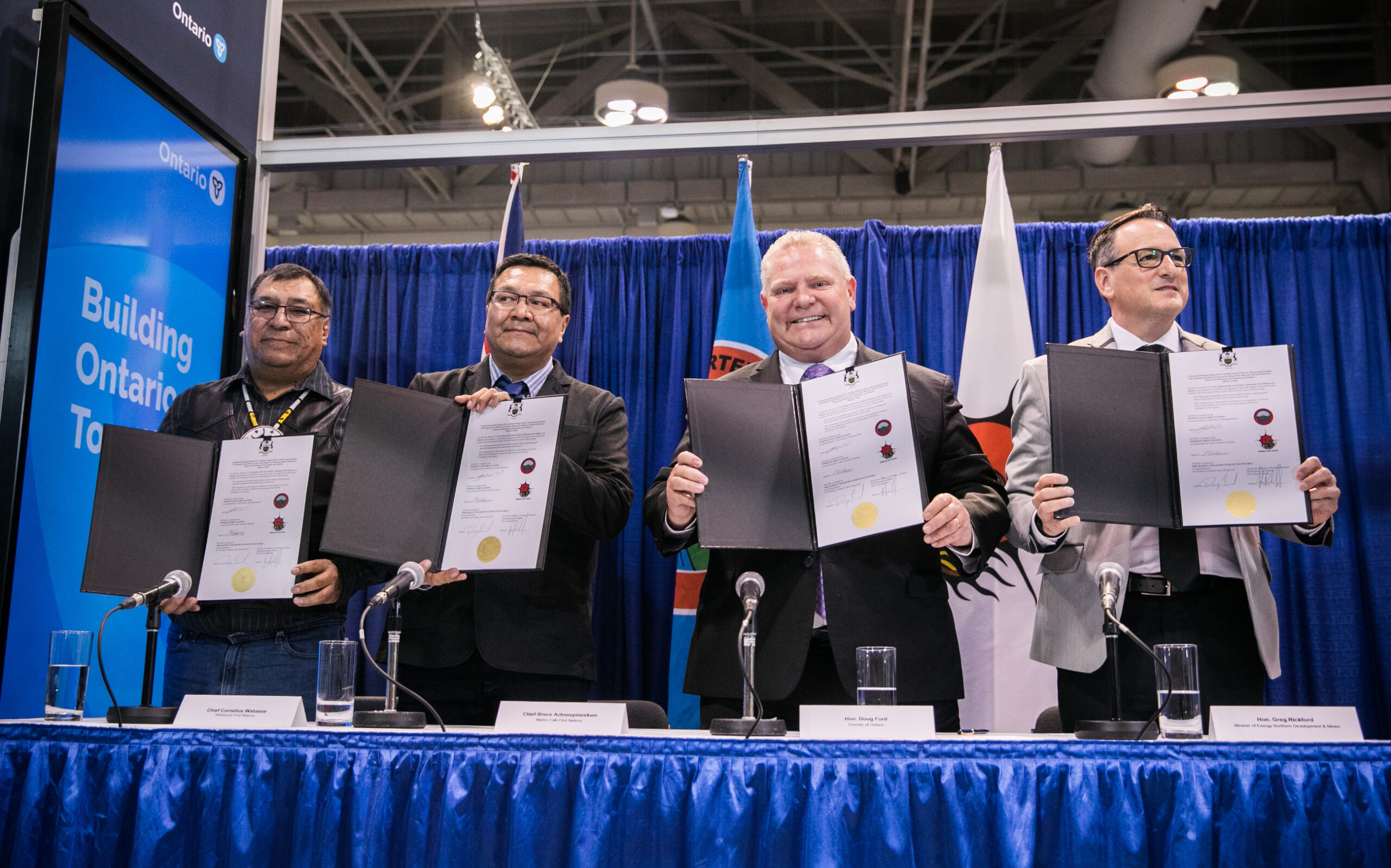
“COVID-19 consultation and engagement challenges persist, and court challenges are likely to continue … the federally initiated regional assessment of the Ring of Fire has created very high expectations from those who oppose road and Ring development and there continue to be calls to halt all [environmental assessments] and planning until the federal regional assessment is complete.”
Sarah Beamish, a lawyer representing Fort Albany First Nation, said the Ontario government’s approach, as written in the meeting note, is “obviously disturbing” but not a surprise. The fact that it chose to push forward despite knowing some First Nations were opposed and likely to file legal challenges “speaks volumes about the honour of the Crown,” she added.
“The fact that the Crown is framing the issue as being about First Nations’ ‘high expectations,’ I think that’s very revealing about the colonial attitudes that are still so present in government,” Beamish said.
Given the ecological and cultural significance of the region, it’s reasonable for communities there to have high expectations for a process that will shape its future, Scott said. So much is at stake.
“It’s perhaps not surprising that [the Ontario government wants] to see opposition to this vision as a minor roadblock to be, kind of, navigated rather than a genuine problem,” Scott said.
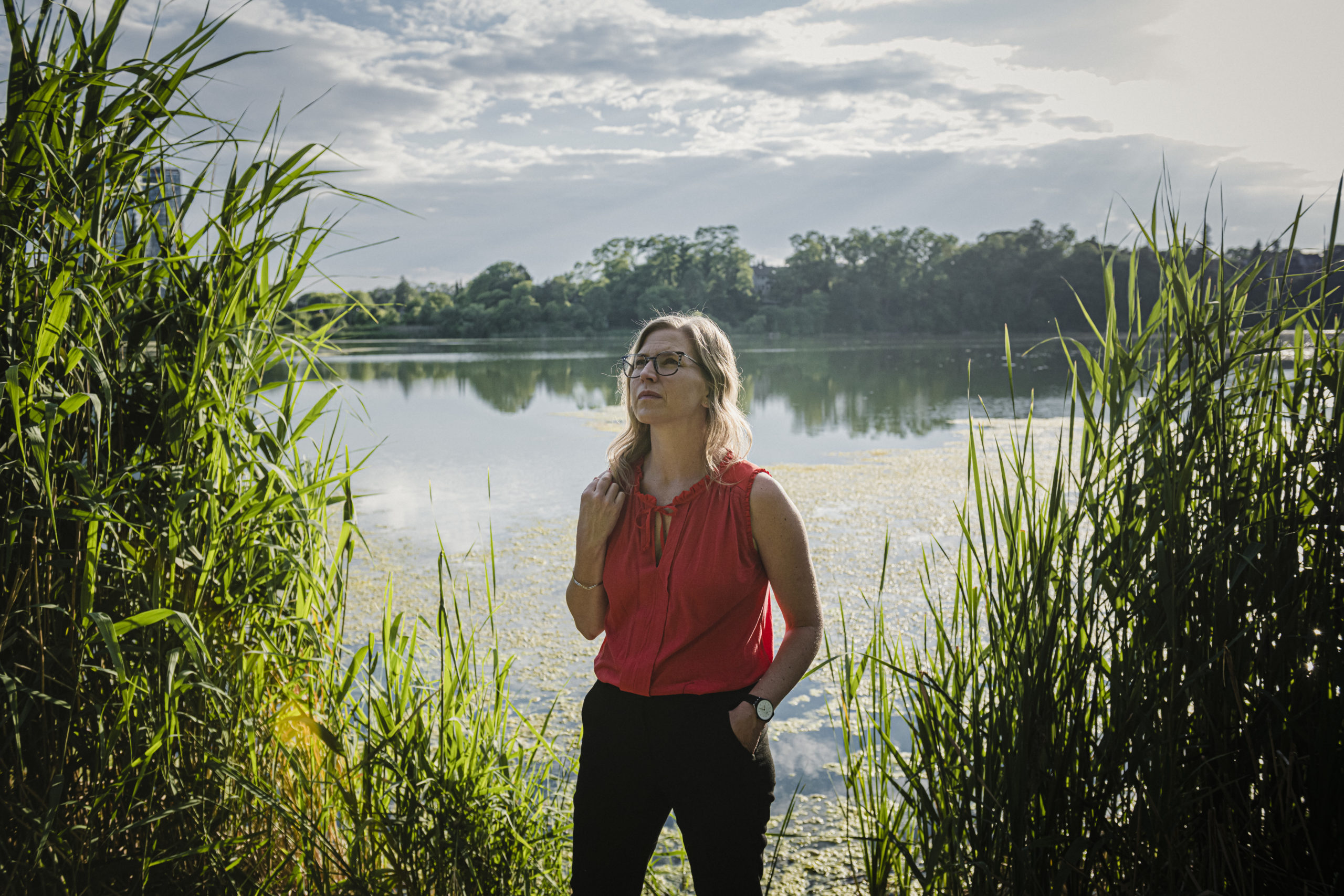
Kempton said Ontario and Canada are latching on to the idea that two First Nations have agreed to road development, while ignoring the fact that other communities, which she said will be “permanently and potentially catastrophically affected,” must also give their consent.
“They’re not looking at this in any other way than from the viewpoint of the Crown governments, and not understanding at all what free prior and informed consent means and having no vision on what it’s going to take to get there,” she said.
“They’re also quite happy with the fact that two First Nations are consenting, manipulating that into a divisive force.”
U.S. mining analyst: the Ring of Fire is ‘just some stupid idea in Canada’
Another looming uncertainty is whether the mineral deposits in the Ring of Fire will actually be worth the money the Ontario government would like to spend to reach them. When mining companies first found minerals there in 2007, the frenzy was around chromite, a vital component of stainless steel. But global demand for chromite has dropped and now the focus is on nickel, which is needed to feed a rapidly growing market for electric vehicle batteries.
Back in 2014, the Ontario Chamber of Commerce estimated the Ring of Fire could contribute as much as $9.4 billion to the province’s GDP in its first 10 years of development and $60 billion over the lifetime of various projects, and sustain 5,500 jobs. However, the calculation was based on a dubious analysis of the value of minerals in the Ring of Fire, done by a geologist who told the Globe and Mail in 2019 that his figure shouldn’t be used and is “just not proper.” Regardless, the Ontario government cited the Chamber of Commerce figures in internal documents as recently as September 2021, freedom-of-information requests by The Narwhal show. The federal government, too, did so internally in April 2021.
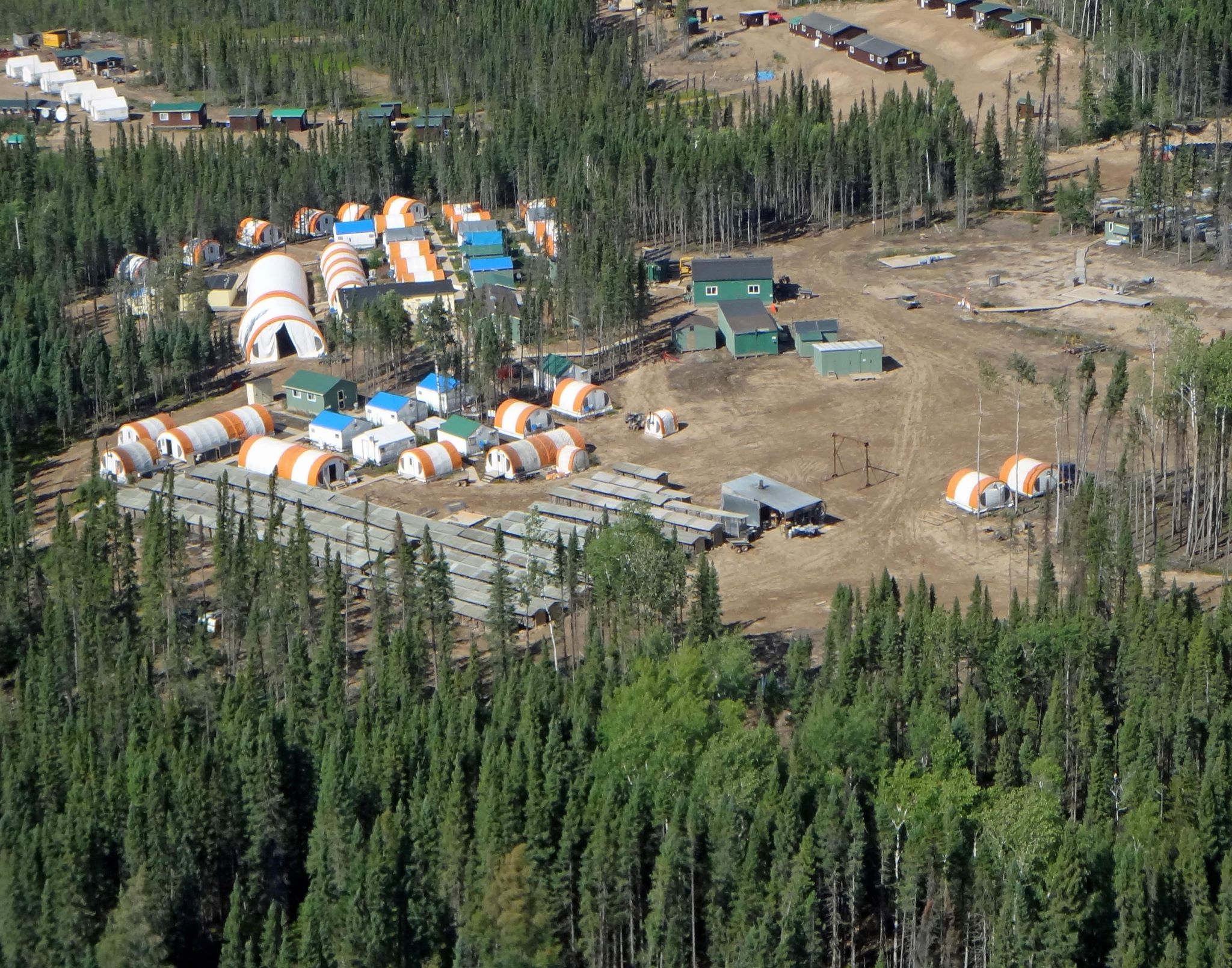
Rickford’s office didn’t answer when asked why it’s relying on outdated numbers. Natural Resources Canada said it has not made any decisions based on the Chamber of Commerce figures.
“Any federal decisions related to mineral development in the Ring of Fire will be based on evidence informed by economic, social and environmental data, and engagement with the Government of Ontario and local First Nations,” the department said in an email.
Patrick Ryan, a consultant with Mining for Facts in the United States, said it’s foolish to base decisions in 2022 on estimates calculated in 2014. The chromite market has changed. COVID-19 and inflation have shifted the global economy. And even though there’s demand for nickel for electric vehicle batteries now, technology can change, and there’s no guarantee it’ll still be needed in a decade.
“The numbers are all already wrong based on inflation and everything else,” Ryan said. “I mean, it’s ridiculous.”
Last year, on the heels of a fall economic statement in which the Ford government once again reiterated its commitment to developing the Ring of Fire, The Narwhal requested the government’s most recent estimate of the value of minerals there through freedom of information, and was told no such records exist. Rickford’s office did not answer questions about whether it has done independent work to assess the mineral deposits’ value.
Ryan said any way you slice it, the Ring of Fire does not make economic sense.
“If it’s such a goddamn good project, why does it depend on massive amounts of government aid?” Ryan said.
“I wouldn’t worry about it because it’s never going to be built … No one really cares. It’s just some stupid idea in Canada.”
‘It is time for us to put pen to paper’
Doug Ford’s Progressive Conservatives have carried over a $1 billion commitment previously made by the former Liberal government to build the infrastructure needed to access the Ring of Fire. In July 2019, Rickford sent the federal government a pitch deck asking Ottawa to match some of that funding and contribute up to $780 million.
“This is a multibillion-dollar project of national significance and Ontario cannot unlock its full potential on its own,” Rickford wrote in an accompanying letter, saying the project would deliver “significant economic benefit to both Canada and Ontario.”
The federal natural resources minister at the time, Seamus O’Regan, wrote back in early September 2019 signalling interest, encouraging Ontario to submit an application for funding through Infrastructure Canada. But that came with a caveat.
“As you know, the Government of Canada is deeply committed to reconciliation with Indigenous Peoples, and will continue to support efforts to advance their economic prosperity and self-determination,” O’Regan wrote.
“The Ring of Fire has tremendous potential toward this end but it must be advanced in consultation and partnership with all affected First Nations. A completed application and business case submitted to the Government of Canada will need to demonstrate that this is the case.”
Soon after that, a federal election was called, and the funding discussion fell by the wayside for two years.
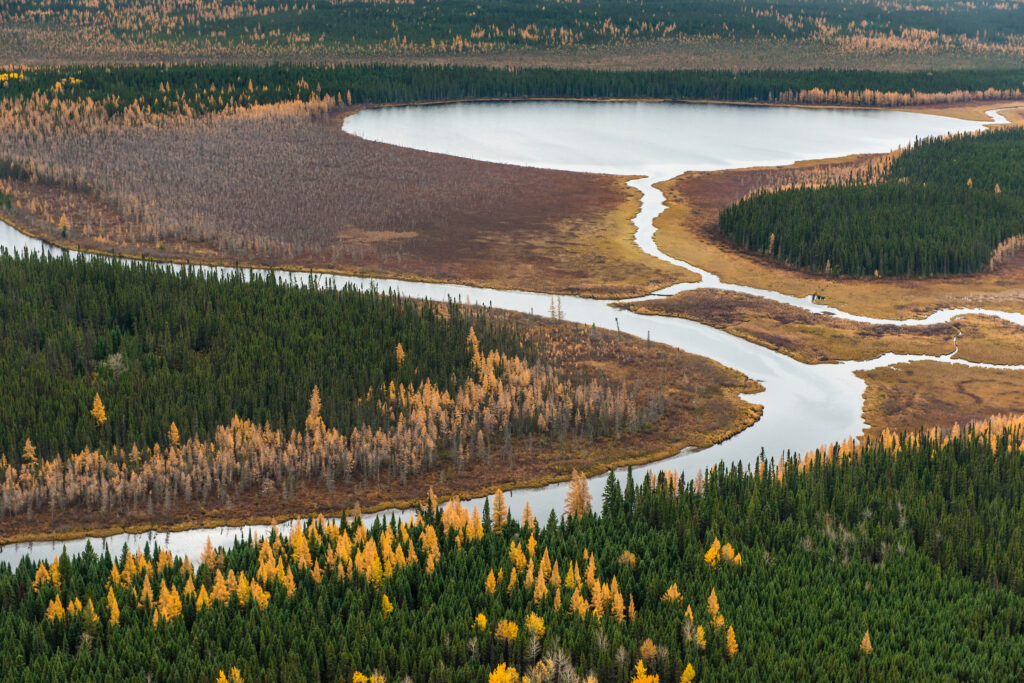
A December 2021 briefing note to current Indigenous Services Minister Patty Hajdu refers to a meeting between Prime Minister Justin Trudeau and Ford in November 2019, which also failed to push the process forward: “Federal officials have yet to receive political direction on next steps,” it said. Though O’Regan and then-federal Indigenous Services Minister Jane Philpott “recommended that senior officials resume discussions on how to best move forward … no substantive discussions at the senior officials’ level have taken place.”
In an email, Natural Resources Canada said it had set aside $1.5 billion over seven years for investments in infrastructure to support the development of certain critical minerals, with a “focus on priority deposits.” But the federal government didn’t say whether the Ring of Fire is a priority deposit.
“Negotiations on the Ring of Fire have not taken place between the Government of Canada and the Government of Ontario to date in 2022,” Natural Resources Canada said.
It’s not clear whether the Ontario government ever requested the money from Infrastructure Canada as O’Regan advised. Rickford’s office did not answer when asked whether it had done so, and the federal government didn’t directly answer a question about whether it had received such an application. A November 2021 briefing note to current Natural Resources Minister Jonathan Wilkinson notes that the federal government “would consider” Rickford’s proposal if Ontario made its case to Infrastructure Canada, implying that this had not happened in the two years since Ottawa first suggested it.
Earlier this year, Rickford resumed attempts to put pressure on Ottawa to come to the table.
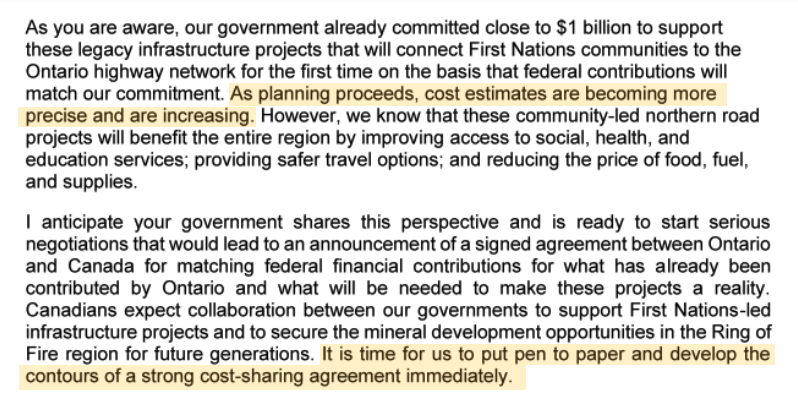

“I anticipate an announcement from your government that would include signing a funding agreement with the province for matching financial contributions of $1 billion to secure this opportunity,” Rickford wrote in a letter to Wilkinson on Jan. 28.
He wrote another letter a few weeks later, on Feb. 18, this time addressing it to Wilkinson, Hajdu and federal Intergovernmental Affairs Minister Dominic LeBlanc. “As planning proceeds, cost estimates are becoming more precise and increasing,” Rickford wrote. “It is time for us to put pen to paper and develop the contours of a strong cost-sharing agreement immediately.” (The Narwhal filed a freedom-of-information request for the latest cost estimate for building roads to the Ring of Fire; the Ontario government refused to release the records.)
Rickford also argued that not only should Ottawa contribute, it must. The Ring of Fire road projects are undergoing assessments from both the federal and provincial governments. Ontario is providing some First Nations with funding to ensure they have the resources they need to fully participate in consultations — and since some of the provincial and federal requirements overlap, Rickford argued that Ontario is essentially “providing funding support to address [federal] legislative requirements,” and should be paid back.
“I feel it is necessary to seek an immediate contribution from Canada as reimbursement for these costs incurred, and I am proposing our officials begin discussions immediately on this initial payment,” Rickford wrote.
Ottawa hasn’t written back yet. “The federal government is developing a response to these letters,” Natural Resources Canada said in an email.
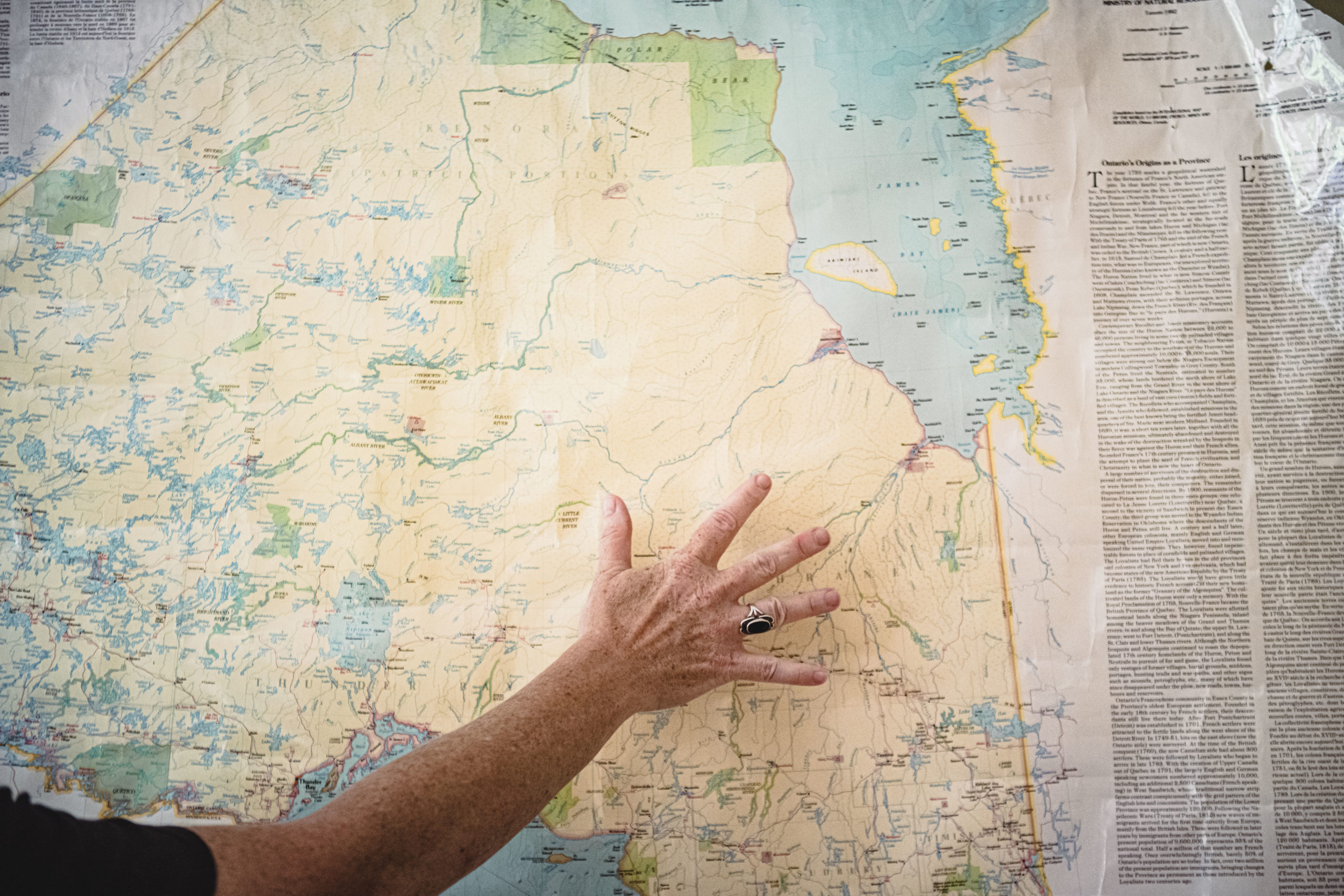
Natural Resources Canada also said it has made “major investments” in helping First Nations “improve socio-economic conditions” and make informed decisions about natural resource development. That includes $39 million to the broadband internet project, $20 million to “support First Nations participation in the mining sector,” $20 million for a community wellbeing pilot project and $6 million to Ontario to cover added costs for consulting with First Nations amid COVID-19.
Other documents suggest Ontario is quietly beginning to think about contingencies.
“If the federal government does not agree to an equal cost-sharing arrangement, then the province will have to consider other options to cover the anticipated federal contribution,” a September 2021 briefing note to Rickford said.
Rickford’s office did not answer questions about what other options those might be. A briefing document prepared a month later for the minister ahead of a mining industry event gave no hint that anything might be off track.
“The next two years will be incredibly important and exciting as the projects advance, leading to what could be the next road to prosperity,” it said.
